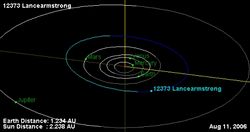Astronomy:12373 Lancearmstrong
| Discovery[1] | |
|---|---|
| Discovered by | C. P. de Saint-Aignan |
| Discovery site | Palomar Obs. |
| Discovery date | 15 May 1994 |
| Designations | |
| (12373) Lancearmstrong | |
| Named after | Lance Armstrong (road racing cyclist)[2] |
| 1994 JE9 · 1997 AP22 | |
| Minor planet category | main-belt · (inner) Vestian |
| Orbital characteristics[1] | |
| Epoch 4 September 2017 (JD 2458000.5) | |
| Uncertainty parameter 0 | |
| Observation arc | 23.05 yr (8,419 days) |
| |{{{apsis}}}|helion}} | 2.7308 AU |
| |{{{apsis}}}|helion}} | 2.1698 AU |
| 2.4503 AU | |
| Eccentricity | 0.1145 |
| Orbital period | 3.84 yr (1,401 days) |
| Mean anomaly | 354.34° |
| Mean motion | 0° 15m 25.2s / day |
| Inclination | 6.7515° |
| Longitude of ascending node | 118.50° |
| 149.65° | |
| Physical characteristics | |
| Dimensions | 3.291±0.264[3] 5±1 km (est. at 0.20)[4] |
| Geometric albedo | 0.449±0.089[3] |
| Absolute magnitude (H) | 14.2[1] |
12373 Lancearmstrong, provisional designation 1994 JE9, is a bright Vestian asteroid from the inner regions of the asteroid belt, approximately 5 kilometers (3.1 miles) in diameter. It was discovered on 15 May 1994, by American astronomer and software engineer Charles de Saint-Aignan after examining films taken at Palomar Observatory, California, and named after American cyclist Lance Armstrong.[5]
Orbital and physical characteristics
The asteroid orbits the Sun in the inner main-belt at a distance of 2.2–2.7 AU once every 3 years and 10 months (1,401 days). Its orbit has an eccentricity of 0.11 and an inclination of 7° with respect to the ecliptic.[1] The body's observation arc begins in 1994, as no precoveries were taken prior to its discovery.[5]
Based on an absolute magnitude of 14.2 and an assumed albedo of 0.20, which is typical for bodies with a silicaceous composition, Lancearmstrong measures between 4 and 6 kilometers in diameter.[4]
According to the survey carried out by NASA's Wide-field Infrared Survey Explorer with its subsequent NEOWISE mission, the asteroid measures 3.3 kilometers in diameter due to an unusually high albedo of 0.449.[3] As of 2016, its composition, shape and rotation period and shape remains unknown.
Naming
This minor planet was named after American Lance Armstrong (born 1971), former professional road racing cyclist. Despite being diagnosed with metastatic testicular cancer, he recovered and returned to cycling. At the time this minor planet was named, he had won the Tour de France three times and encouraged athletes and cancer survivors worldwide.[2][6] The approved naming citation was published by the Minor Planet Center on 1 November 2001 (M.P.C. 43762).[7] In 2012, Armstrong was stripped of his Tour de France victories after a doping scandal.
See also
- List of minor planets named after people
- List of exceptional asteroids
- Meanings of asteroid names – Lancearmstrong
References
- ↑ 1.0 1.1 1.2 1.3 "JPL Small-Body Database Browser: 12373 Lancearmstrong (1994 JE9)". Jet Propulsion Laboratory. https://ssd.jpl.nasa.gov/sbdb.cgi?sstr=2012373.
- ↑ 2.0 2.1 Schmadel, Lutz D. (2007). "(12373) Lancearmstrong". Dictionary of Minor Planet Names – (12373) Lancearmstrong. Springer Berlin Heidelberg. p. 780. doi:10.1007/978-3-540-29925-7_8578. ISBN 978-3-540-00238-3.
- ↑ 3.0 3.1 3.2 Masiero, Joseph R.; Mainzer, A. K.; Grav, T.; Bauer, J. M.; Cutri, R. M.; Dailey, J. et al. (November 2011). "Main Belt Asteroids with WISE/NEOWISE. I. Preliminary Albedos and Diameters". The Astrophysical Journal 741 (2): 20. doi:10.1088/0004-637X/741/2/68. Bibcode: 2011ApJ...741...68M. http://adsabs.harvard.edu/cgi-bin/bib_query?bibcode=2011ApJ...741...68M. Retrieved 4 December 2016.
- ↑ 4.0 4.1 "Absolute Magnitude (H)". NASA/JPL. http://neo.jpl.nasa.gov/glossary/h.html.
- ↑ 5.0 5.1 "12373 Lancearmstrong (1994 JE9)". Minor Planet Center. https://www.minorplanetcenter.net/db_search/show_object?object_id=12373.
- ↑ Ash, Russell (10 November 2011). Boring, Botty and Spong. RHCP. p. 20. ISBN 978-1-4090-9739-6. https://books.google.com/books?id=bb-UfSQy7xYC&pg=PA20.
- ↑ "MPC/MPO/MPS Archive". Minor Planet Center. https://www.minorplanetcenter.net/iau/ECS/MPCArchive/MPCArchive_TBL.html.
External links
- Asteroid Lightcurve Database (LCDB), query form (info )
- Dictionary of Minor Planet Names, Google books
- Asteroids and comets rotation curves, CdR – Observatoire de Genève, Raoul Behrend
- Discovery Circumstances: Numbered Minor Planets (10001)-(15000) – Minor Planet Center
- 12373 Lancearmstrong at AstDyS-2, Asteroids—Dynamic Site
- 12373 Lancearmstrong at the JPL Small-Body Database
 |


